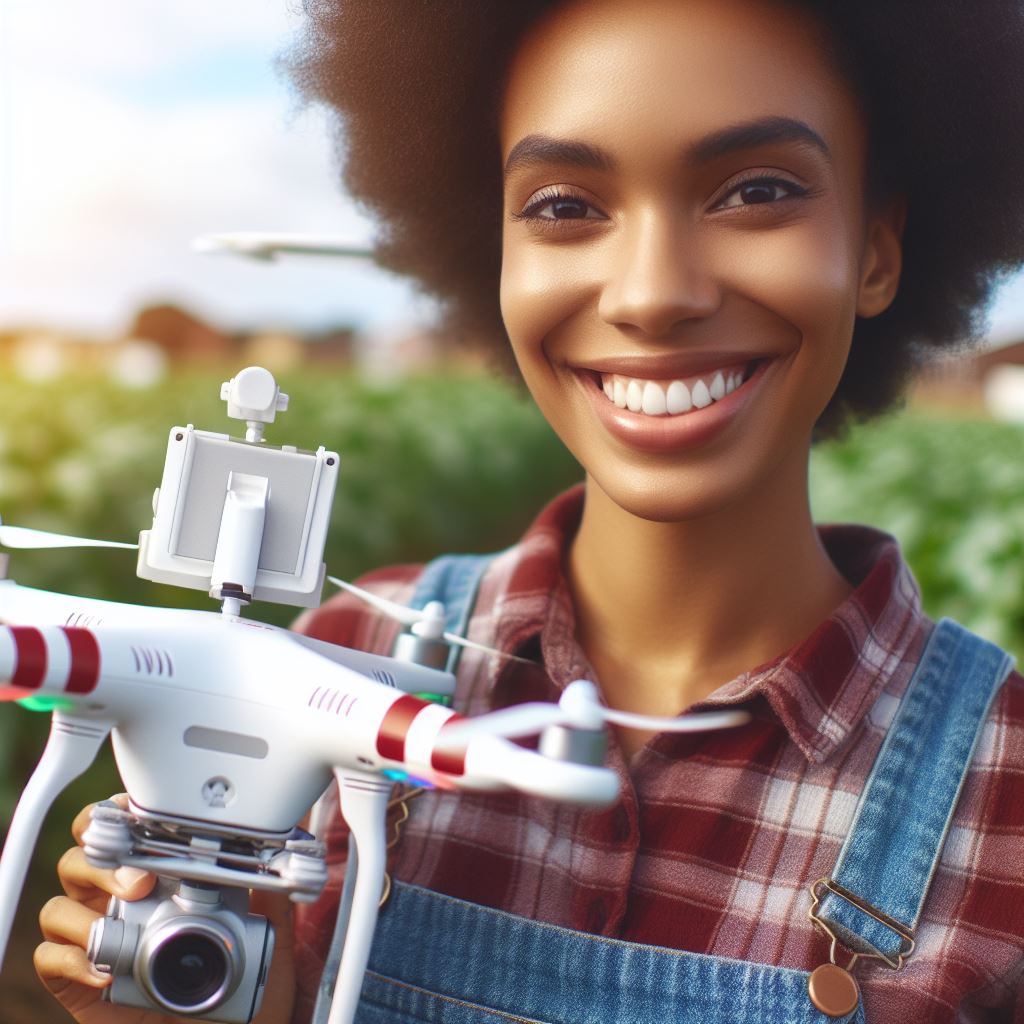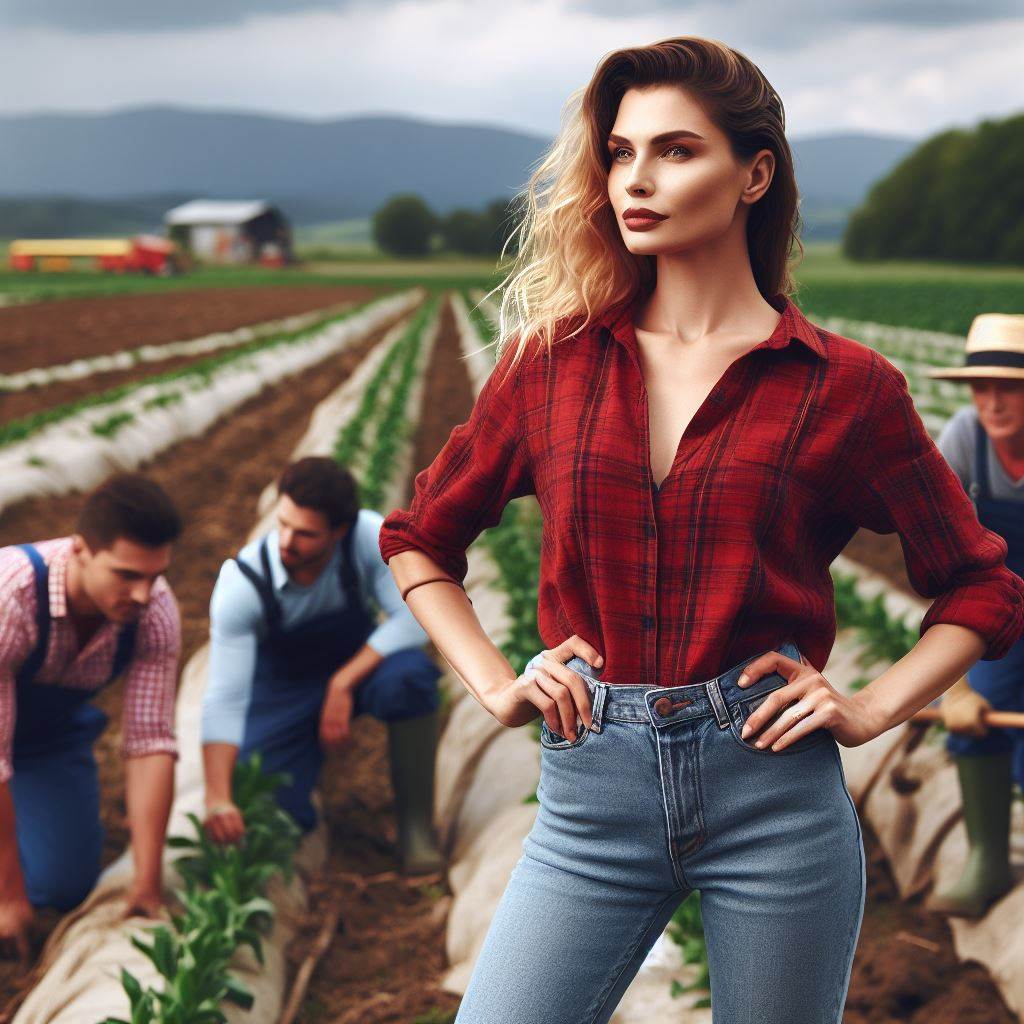Introduction
Farm drones have revolutionized modern agriculture by providing farmers with an efficient and cost-effective solution to their farming operations.
These unmanned aerial vehicles, equipped with various sensors and cameras, have proven to be highly beneficial in improving farming practices.
The concept of farm drones involves the use of unmanned aerial vehicles that are specifically designed to carry out tasks related to farming.
These drones are equipped with advanced technology, such as GPS, infrared cameras, and sensors, which allow farmers to monitor crops, analyze soil conditions, and detect plant health issues.
Aerial efficiency is of utmost importance in modern farming practices.
By utilizing farm drones, farmers can save time and reduce manual labor, allowing them to cover large areas of land in a short period.
These drones can collect real-time data and provide farmers with valuable insights into their crops’ health and growth patterns.
Furthermore, farm drones enable farmers to optimize the use of resources like water, fertilizers, and pesticides by precisely targeting areas that require attention.
This aerial efficiency not only reduces input costs but also minimizes environmental impact by minimizing the use of chemicals.
Farm drones also play a vital role in crop monitoring and surveillance.
They can help farmers identify potential pest infestations, diseases, or irrigation issues, allowing for timely interventions.
This early detection enables farmers to take necessary actions promptly and prevent the spread of diseases, thus saving their crops and maintaining higher yields.
In fact, farm drones have emerged as a game-changer in modern agriculture, providing farmers with aerial efficiency and improved productivity.
These unmanned aerial vehicles offer accurate data collection, crop monitoring, and resource optimization, ultimately leading to sustainable farming practices.
The Evolution of Farm Drones
Historical background on the development of farm drones
- Farm drones have a rich history, dating back to the 1930s when the first remote-controlled aircraft were used.
- Initially, these early models were used for military purposes, such as surveillance and target practice.
- The agricultural sector recognized the potential of drones and started exploring their use in farming operations.
- In the 1980s, the first commercial agricultural drones were introduced, mainly used for crop monitoring and aerial imaging.
- These early farm drones were bulky and expensive, requiring skilled operators to fly them.
Initial uses and limitations of early farm drone models
- Early farm drones were primarily used for crop monitoring, assessing plant health, and identifying pest infestations.
- These drones helped farmers identify problem areas in their fields quickly and take necessary actions.
- However, their limited battery life and payload capacity restricted their efficiency and effectiveness.
- The drones could only cover small areas, and frequent battery replacements were needed during extended flights.
- Additionally, the quality of images and data collected by these drones was not always reliable or accurate.
Advancements in technology and their impact on the effectiveness of farm drones
- Technological advancements have revolutionized the capabilities of farm drones.
- Improved battery technology has increased flight times, allowing drones to cover larger areas in a single flight.
- Miniaturization of components has made drones smaller, lighter, and more agile, enabling them to navigate through narrow spaces.
- Enhanced sensors and imaging systems provide high-resolution, real-time data for precision farming practices.
- Artificial intelligence and machine learning algorithms analyze data collected by drones, enabling better crop management decisions.
- Integration with satellite imagery, weather data, and GPS systems allows for better planning and optimization of farming operations.
- The use of thermal imaging cameras in drones helps detect variations in plant temperature, aiding in irrigation management.
- Drones can now perform various tasks such as seeding, spraying fertilizers and pesticides, and even harvesting crops.
- These advancements not only improve efficiency but also reduce the need for manual labor, saving time and resources.
In short, farm drones have come a long way from their early beginnings in the military to their vital role in modern agriculture.
Historical developments have paved the way for the current state of farm drones, with new technologies continuously enhancing their capabilities.
As further innovation occurs, farm drones have the potential to revolutionize agriculture, increasing productivity, sustainability, and overall aerial efficiency.
Read: Eco-Friendly Farming: One Family’s Path
Benefits of Farm Drones
Drones have revolutionized the farming industry by offering numerous benefits to farmers.
Let’s explore some of these advantages in detail:
Increased crop monitoring capabilities
Farm drones provide farmers with the ability to monitor their crops in a more efficient and accurate manner.
By using drones for quick and precise crop health assessments, farmers can identify any potential issues and take immediate action.
Drones also help in identifying and addressing crop diseases more efficiently, allowing farmers to intervene before the diseases spread and cause significant damage.
Precision agriculture and data analysis
Precision agriculture is the use of technology to optimize farming practices.
Drones play a crucial role in this aspect by collecting accurate field data, which helps in making better decisions.
By flying over the fields and capturing data such as soil moisture levels, crop growth patterns, and nutrient deficiencies, drones provide valuable insights to farmers.
This data can then be analyzed to optimize resource allocation and improve overall productivity.
Enhanced spraying and seeding techniques
One of the most significant advantages of using farm drones is their ability to enhance spraying and seeding techniques.
Drones can be equipped with specialized equipment for targeted and precise application of pesticides and fertilizers.
This allows farmers to minimize waste and reduce environmental impact.
Additionally, drones can improve seed dispersal, ensuring a more uniform crop growth and better overall yield.
In essence, farm drones bring numerous benefits to the agriculture industry.
They enhance crop monitoring capabilities, facilitate precision agriculture and data analysis, and improve spraying and seeding techniques.
By leveraging the power of aerial efficiency, farmers can optimize their operations, increase productivity, and contribute to sustainable farming practices.
Read: Veteran to Farmer: A Tale of Transition

Challenges and Potential Limitations
Agricultural drone technology has the potential to revolutionize farming practices, but it comes with its fair share of challenges and limitations.
In this section, we will explore some of the key obstacles that need to be overcome for the widespread adoption of farm drones.
Transform Your Agribusiness
Unlock your farm's potential with expert advice tailored to your needs. Get actionable steps that drive real results.
Get StartedLegal and regulatory considerations for drone operation in agriculture
- The use of agricultural drones raises concerns regarding privacy, airspace regulations, and liability issues.
- Government regulations that govern drone operations in agriculture can vary across different countries and regions.
- Farmers need to comply with licensing, training, and certification requirements to legally operate drones for farming purposes.
- Strict restrictions on altitude, distance, and flight patterns may limit the efficiency and effectiveness of farm drone operations.
Initial investment and associated costs
- Acquiring agricultural drones involves significant upfront investment, which may be a barrier for small farmers.
- The cost of purchasing high-quality drones and related equipment, such as cameras and sensors, can be substantial.
- Training personnel to operate and maintain drones adds to the initial investment and ongoing costs.
- Insurance premiums may also be higher due to the potential risks and accidents associated with drone use.
Maintenance and repair requirements
- Regular maintenance and servicing of agricultural drones are necessary to ensure optimal performance.
- Any technical issues or damage to drones can lead to downtime and financial losses for farmers.
- Access to qualified technicians and spare parts may be limited, especially in remote farming areas.
- Proper storage and transportation of drones are essential to prevent damage during non-operational periods.
Limitations regarding flight time, payload capacity, and battery life
- Farm drones often have limited flight time, which can restrict their coverage and efficiency in large agricultural areas.
- The payload capacity of drones may not be sufficient to carry heavier agricultural tools or equipment.
- Battery life is a significant limitation, requiring frequent charging or battery replacement, affecting continuous operations.
- Technological advancements in battery life and payload capacity are necessary to overcome these limitations.
In general, although agricultural drones offer promising benefits for farmers, several challenges need to be addressed before their widespread adoption.
Legal and regulatory considerations, initial investment costs, maintenance requirements, and limitations related to flight time, payload capacity, and battery life pose significant obstacles.
However, as technology progresses and regulations adapt to reflect the potential of farm drones, these limitations can be overcome, paving the way for aerial efficiency in agriculture.
Read: Artisan Cheese: Small Farm Success Story
Case Studies: Successful Implementation of Farm Drones
Examples of farms or agriculture companies effectively utilizing farm drones
- Smith Farms – By implementing farm drones, Smith Farms saw a significant increase in crop yield and efficiency.
- Green Acres Agriculture – Utilizing farm drones allowed Green Acres Agriculture to accurately monitor crop health, leading to better pest control.
- Harvest Co. – Harvest Co. used farm drones to survey their vast fields and identify areas for irrigation, improving water usage efficiency.
Benefits experienced by these enterprises
- Increased crop yield – With the help of farm drones, these enterprises experienced higher agricultural productivity.
- Efficiency improvement – Farm drones allowed for precise monitoring and timely intervention, minimizing resource wastage.
- Cost reduction – By optimizing crop treatments and resource allocation, these enterprises saved on labor and input costs.
- Accurate data collection – Farm drones provided real-time, high-resolution imagery and data for analysis, aiding in informed decision-making.
- Better resource management – By identifying crop health issues early, these enterprises could effectively allocate resources for timely intervention.
Lessons learned and recommendations for others considering farm drone adoption
- Plan drone usage based on specific farm needs and requirements to maximize its benefits.
- Invest in a reliable drone model equipped with advanced sensors and imaging capabilities.
- Train farm personnel to operate drones properly and interpret the data collected by them.
- Regularly update and calibrate the drone’s sensors and cameras for accurate measurements.
- Formulate a systematic data management and analysis strategy to make the most of drone-collected data.
- Establish protocols and guidelines for safe drone operation, ensuring compliance with local regulations.
- Prioritize data security and privacy, implementing measures to protect sensitive information collected by drones.
- Continuously evaluate and adapt drone usage based on feedback and insights gained through practical implementation.
By analyzing successful case studies and understanding the benefits and challenges faced by enterprises, other farms and agriculture companies can make informed decisions about farm drone adoption.
With careful planning, proper training, and efficient data management, farm drones can revolutionize agricultural practices, leading to increased productivity and sustainable farming.
Read: Aquaponics in Action: Small Scale Farming
Future Possibilities and Innovations
Promising advancements and upcoming technologies in farm drones
Farm drones have already proven their worth in revolutionizing agriculture, but the future possibilities are even more exciting.
Advancements in payload capacity, battery life, and specialized sensors will enhance their capabilities further.
Integrating drones with technologies like AI, data analytics, robotics, and IoT will unlock new levels of efficiency and innovation in farming.
Potential integration with other farming technologies, such as AI and data analytics
Imagine a future where drones autonomously survey and analyze crops, detecting diseases and pests at an early stage.
AI algorithms crunch the data and provide real-time recommendations for targeted interventions, optimizing yield and minimizing waste.
Drones equipped with robotic arms handle planting, weeding, and harvesting tasks with precision and speed, reducing labor costs and increasing productivity.
The impact of farm drones on the agriculture industry cannot be understated.
With increased efficiency, optimized resource usage, and improved decision-making, farmers will experience significant improvements in yield, profitability, and sustainability.
Additionally, the environmental benefits of reduced chemical inputs and soil erosion contribute to a more eco-friendly approach to farming.
Predictions on the future impact of farm drones on the agriculture industry
The future of agriculture is in the skies with drones playing a crucial role.
These aerial marvels are set to democratize access to advanced farming technologies and empower small-scale farmers worldwide.
Affordable drone solutions will level the playing field, enabling sustainable agriculture practices and ensuring food security for all.
As technology continues to evolve, the integration of farm drones with other cutting-edge technologies will only amplify their potential.
The future possibilities are endless, and the advancements being made in the industry are transforming agriculture into a smarter, more efficient, and sustainable sector.
Farm drones are truly paving the way for the future of aerial efficiency in farming.
Conclusion
Recap of the benefits and potential drawbacks of farm drones
Farm drones offer numerous benefits such as increased efficiency, reduced costs, and improved crop monitoring.
However, there are also potential drawbacks to consider such as high initial investment and regulatory restrictions.
Final thoughts on the promising future of aerial efficiency in farming
The use of farm drones represents a promising future for agriculture, revolutionizing the way farmers operate and increasing overall productivity.
With advancements in technology, the potential for aerial efficiency in farming is tremendous.
Call-to-action for readers to stay updated on farm drone developments
To stay informed about the latest developments in farm drone technology and its impact on the agricultural industry, follow reputable sources, join online communities, and connect with industry experts.
Join the aerial evolution in farming!




